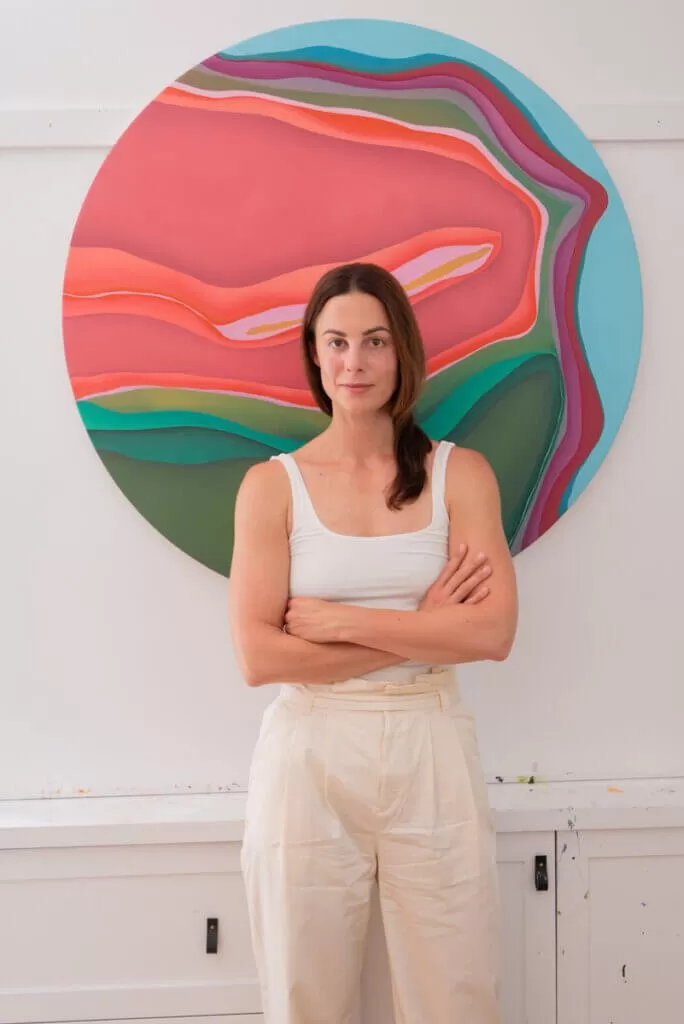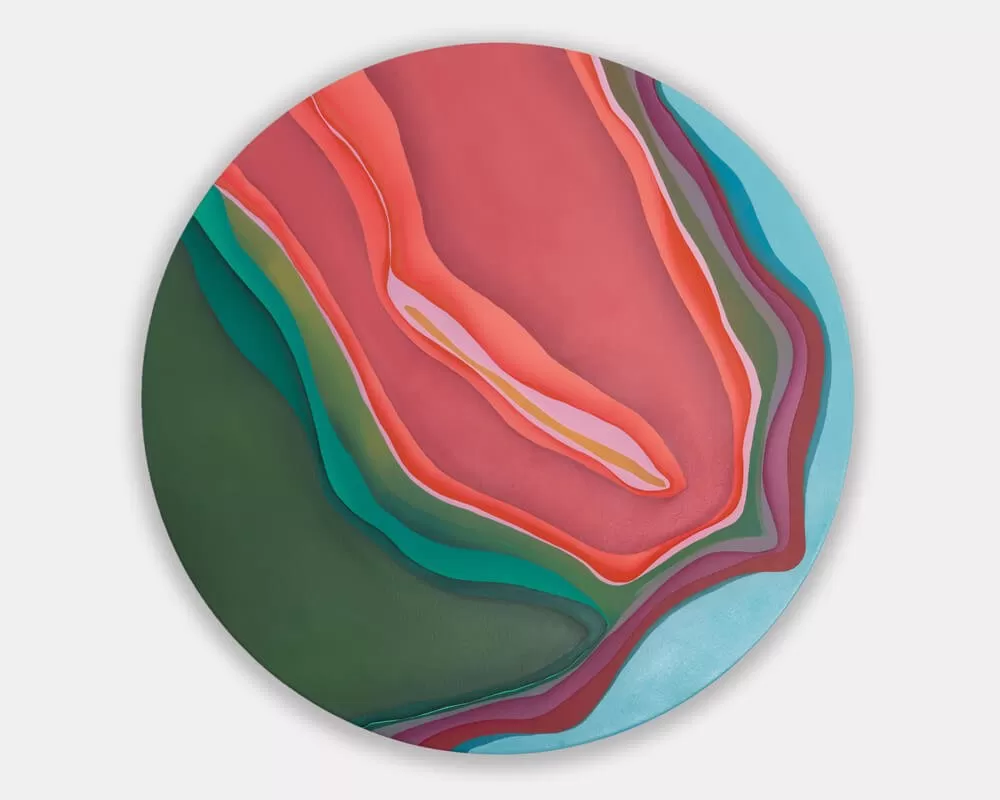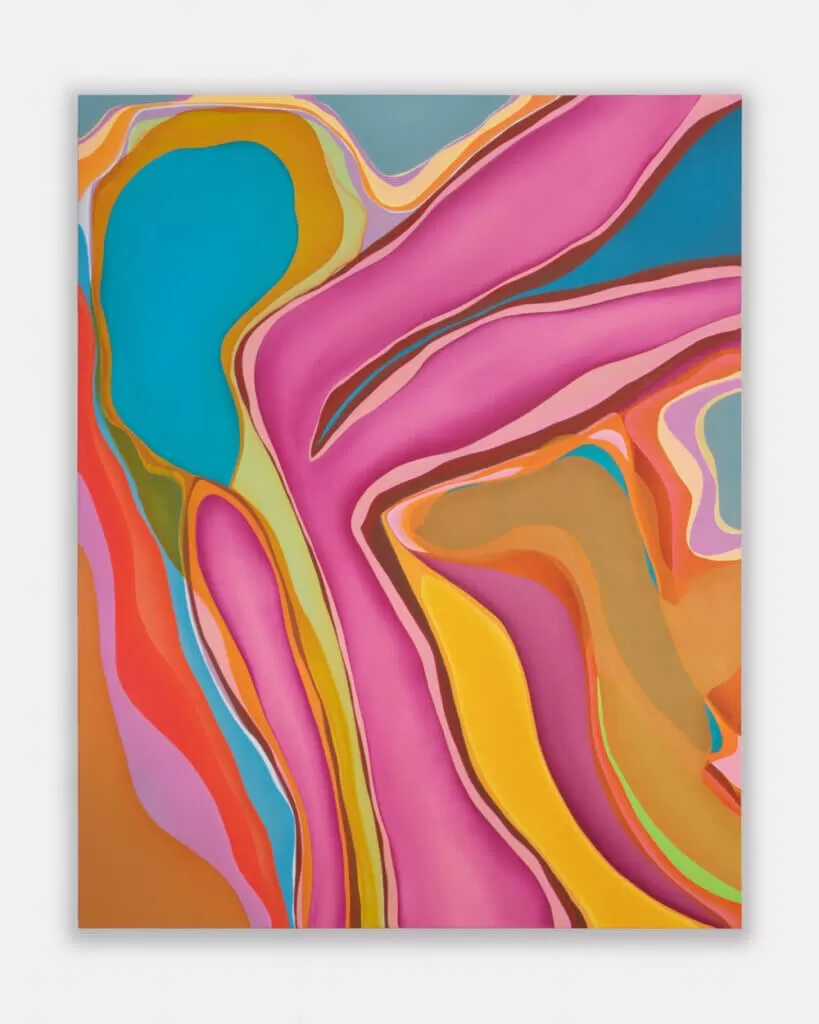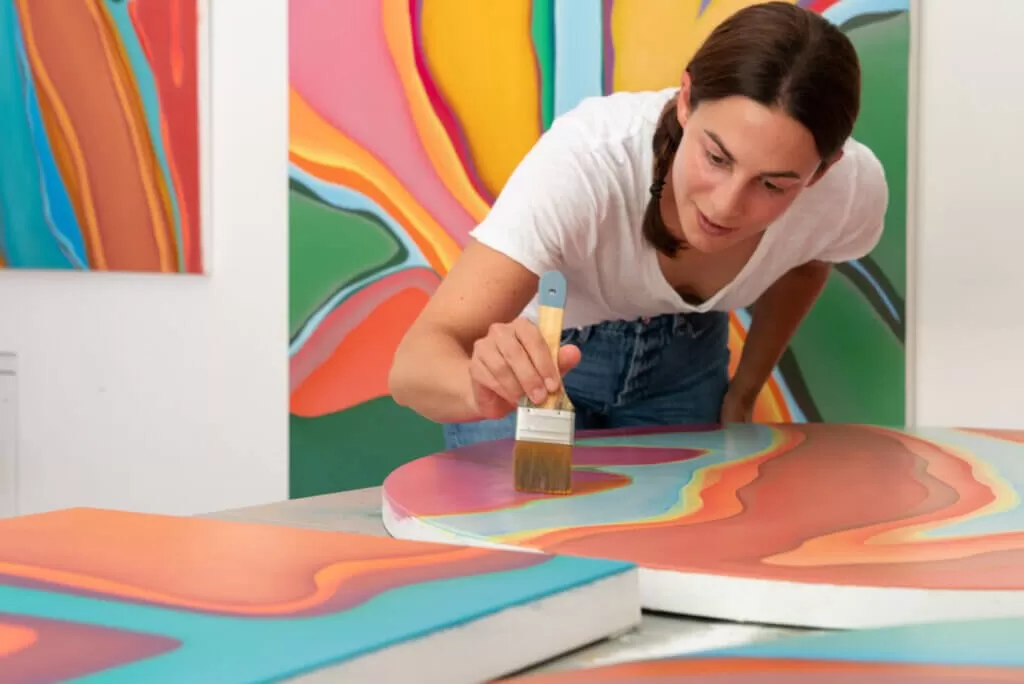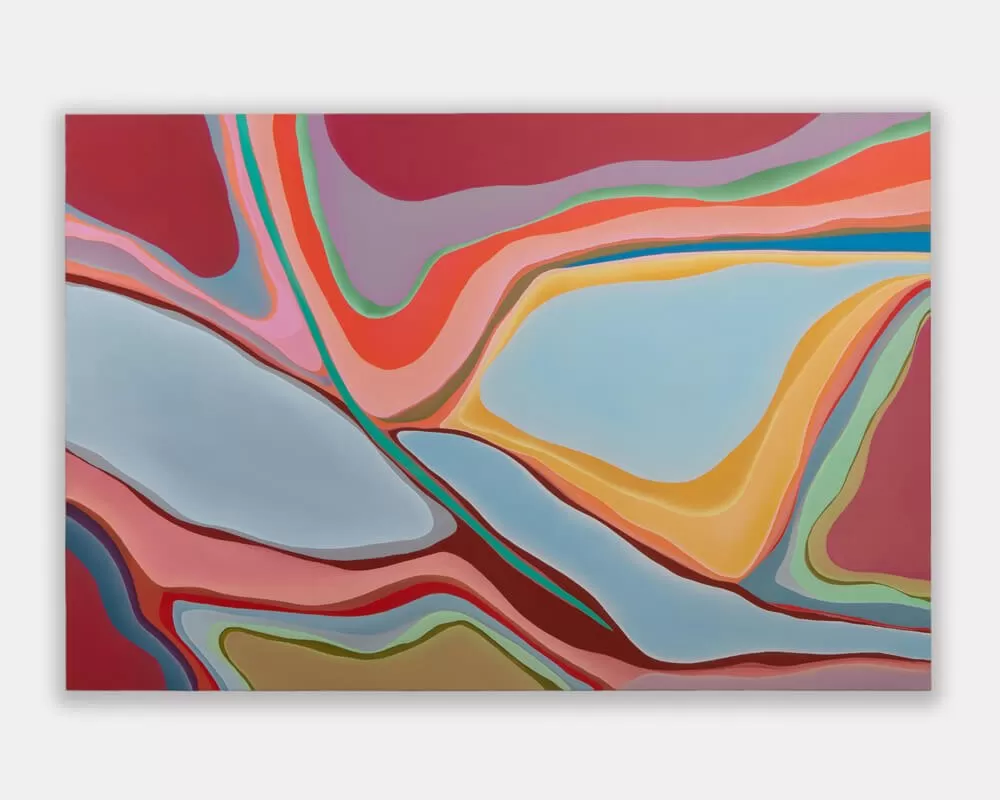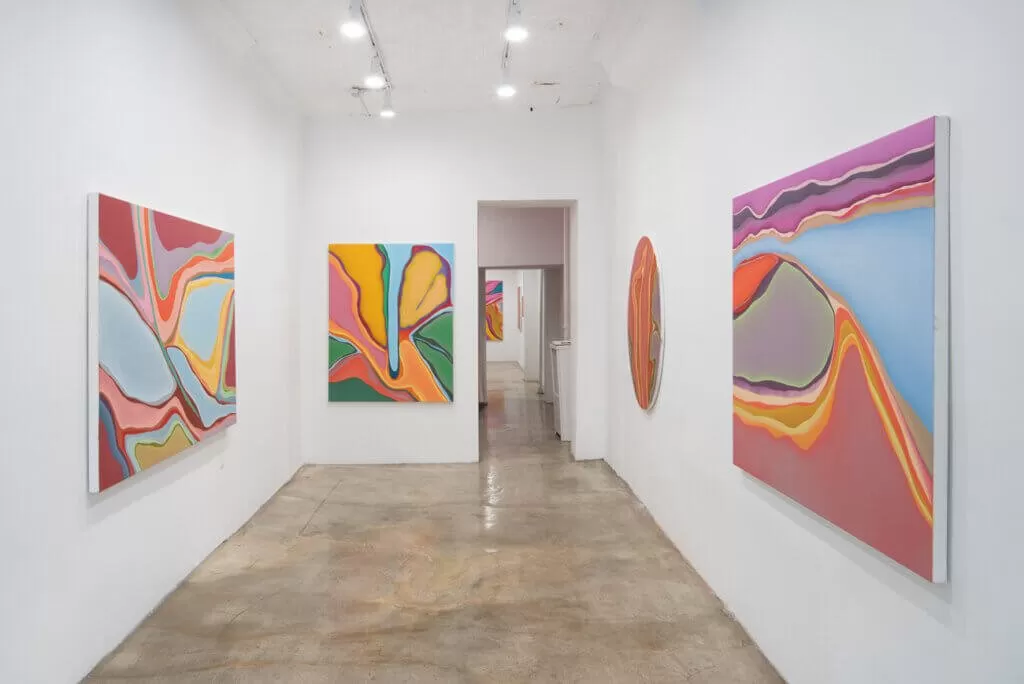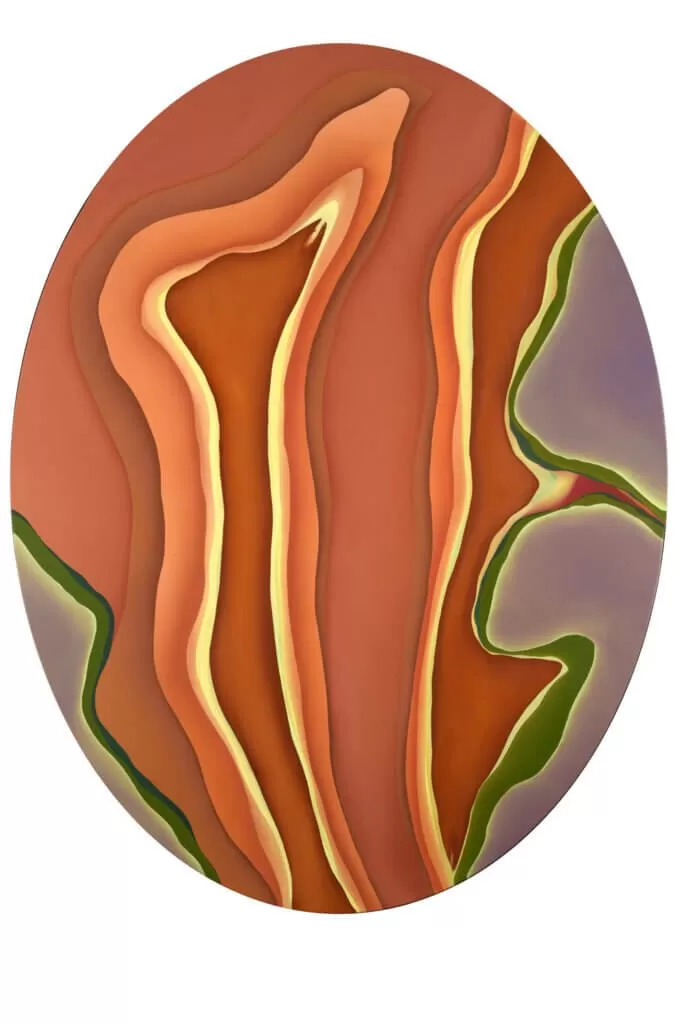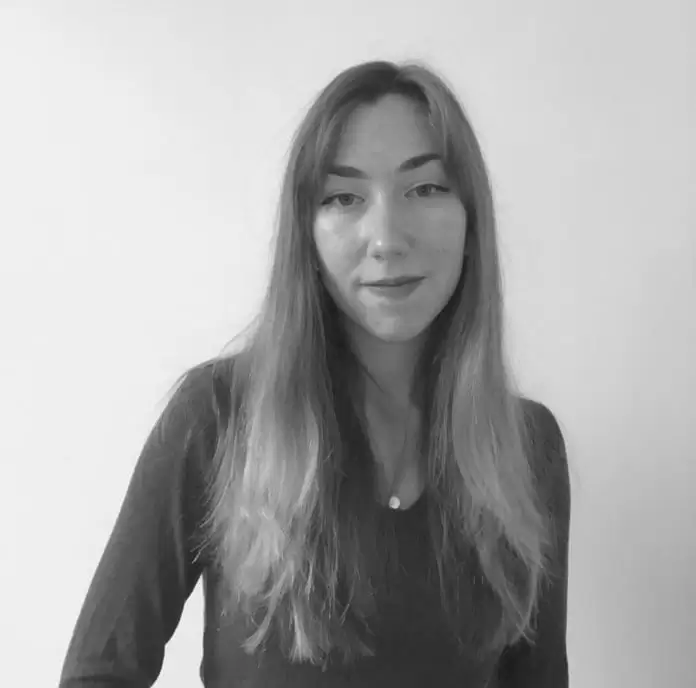Bethany Czarnecki’s approach to representing gender and identity is as layered as her paintings themselves. The Connecticut-based painter is known for her expressive paintings exploring topics of gender, identity, femininity, and sensuality. Her works draw out certain powerful essences of these themes, imagining their meanings and presences in the world in new ways.
On canvas, Czarnecki’s ideas come to life on rolling waves of saturated strokes of paint and on dreamy ravines of vivid colour. These works envelope the viewer in an immersive, sensory experience. They simultaneously evoke the realm of the physical while giving a glimpse into the world of the psychological and even spiritual. They are intimate yet liberated and meant to be felt, not just seen and admired.
I create vibrational energy that feels alive and human through colour and form. The paintings emit feelings of arousal, joy, excitement but can also be melancholy—emotions felt by humanity
Bethany Czarnecki
Czarnecki’s works are inherently fluid. They benefit from the artist’s ability to balance transparency and openness with ambiguity and intention, visually and thematically. Issues of gender and sensuality are treated in a contemplative and meditative way by Czarnecki, who generously draws on personal experience and reflects on the weight of these issues in the context of the world today.
Employing femininity and the female experience as subjects requires such adaptability, especially considering the fine line between critiquing previous types of representation and opening up new modes of appreciation.. Czarnecki’s work proves it is not only possible to strike this balance but that it can result in a beautiful visual and intellectual rhythm entirely on its own.
In discussing her recent solo exhibition with Massey Klein Gallery in New York this autumn, Czarnecki provided us with further insight into her practice in the studio, her perspective on gender and femininity, and past and present artistic influences. The artist details her latest exhibition, splendour, which ran from 16 October 2021- 20 November 2021.
Q: Your practice is influenced by so many distinct references: it seems you’ve been compared to some large figures from art history, including Georgia O’Keeffe, Judy Chicago, etc. Who or what exactly would you say influenced your work the most when you first developed your artistic practice? What inspired your interest in the female form and this topic of sensuality and spirituality?
Bethany Czarnecki: I would flip through Georgia O’Keeffe books as a young girl, trying my hand at her flower paintings with oil pastels. I always found them so beautiful and bold in scale. The exercise at a young age allowed me to embrace abstract line-making. However, since then, I have not had a direct path to the studio, so although that exercise probably fed my subconscious for painting, it was not a direct link.
It is important to me to make authentic paintings on subject matter that I can speak to, defend and be challenged by. I refer to many women artists when thinking about the context of painting.
The landscapes and floral paintings of Georgia O’Keefe are indirectly embedded in my work, as is Judy Chicago’s emphasis on gradient colour and light and Joan Semmel’s exploration of the body. Huguette Caland is a painter whose sentiment and work has had a tremendous impact on how I view the tone of my paintings — her work has taught me how compositionally minimal, reductive paintings of the female form can hold power.
Q: How do you view your own position in the art world today, as a female artist working primarily on themes related to women and the female form? Do you perhaps see an urgency or need for more representation in the field either artistically or thematically?
Bethany Czarnecki: I am in the early phase of my career with a long runway ahead of me. It remains to be seen how my work fits within the wider context of the field, but I will continue to push myself in the studio and evolve my voice. As for representation, I have noticed a shift toward highlighting the work of women and other marginalized groups institutionally and beyond as of late. But there is always more work to do in this regard.
Q: Your use of medium and material is important for your practice in many ways. What does your process of creating new work typically look like? How much do you plan and prepare when making these abstracted compositions and how much of the final result comes about naturally or through organic improvisation?
Bethany Czarnecki: When I am in the studio, I focus on my movement. I paint instinctually throughout the canvas, with each action responding to the last. My process of mixing and layering colour is intuitive. The painting evolves as I layer various viscosities and hues of paint onto it. I rarely use brushstrokes as a painterly language.
I prefer to use clear, clean lines made by hand with a brush, layer, upon layer. I typically work flat on tables, hovering over the canvases as I paint them. The energy is slow and meticulous.
I paint very close to work, with my eye only inches away from the canvas—allowing me to create intense colour fields. My process is visceral, with very little planning before diving into the work. The paintings are sensory, immersive and vibrational—the allusion and tone of the work is premeditated and something I think about often. The sentiment of the work is my primary focus. The rest evolves as the conversation between layers of paint mature and take shape.
Q: Could you briefly describe your use of colour in your work and why it is important for the artwork itself? How did your distinct use of colour come about?
Bethany Czarnecki: I create vibrational energy that feels alive and human through colour and form. The paintings emit feelings of arousal, joy, excitement but can also be melancholy—emotions felt by humanity. Colour is my language as it allows me to make atmospheric work and convey tone. I use colour and light as a narrative device to connect with the viewer.
In paintings, you can have hints of natural and divine light—I try to accomplish elements of both. I embrace gradients and swaths of translucent overlays to evoke a perspective beyond the physical form.
Q: Your work can be described as erotic and sensual. What it is about this subtle eroticism and the female body that speaks to you as an artist? How do you feel about the interpretation that your work is empowering toward women in terms of embracing female sexuality? Is this accurate or perhaps reductive to the message of your work?
Bethany Czarnecki: My work teeters on the edge of eroticism in an existential way. Huguette Caland’s words “eroticism is life” are resoundingly pure. She distils the sentiment perfectly, and I do often recall her words to mind as I think about the context of my work.
I do not spend a lot of time thinking about the female body, but rather the sentiment of a female—the essence of femininity, the psyche. I prefer to think of the work as a representation of feminine essence. My paintings are organic and born from the context of being a life-bearing force and explore how life and sensuality are commingled.
Q: For a large portion of art history, we’ve been exposed to mostly representations of the female body that can be considered quite problematic or harmful. When developing your practice, did you find you had to re-learn conceptions of the female body when it comes to art and representation? Do you ever face any regular challenges in the studio or in thinking about new work? Are there any questions or issues you regularly grapple within your practice?
Bethany Czarnecki: The male gaze and its representations of the female form have claimed a place in the history of art. I suppose it is a philosophical debate whether it can be bypassed when making overtly feminine or sensual paintings and debatable whether a painting that explores female sensuality and the body can fully emancipate itself from that element of our cultural lineage.
What differentiates my work from this point of view is that my paintings highlight the feminine as a life force, which includes themes of eroticism and sensuality among others.
The paintings reference the female body and the sensation of female bodily action and emotion. Abstraction is a wonderful tool to strip away subjectification while hopefully creating space for a more nuanced female presence. I prefer to think of the work as representing the intrinsically feminine rather than objectifying the female body.
I challenge myself to reinterpret the notions discussed above on the canvas. With paint as a tool of expression, I am continually looking for angles to push the work forward. For me, it is impossible to separate the cultural and philosophical questions from the painting process.
Q: One of the most striking things about your work is how atmospheric and experiential it is. How do you create this effect visually and what are your intentions here? Is this related to how you want viewers to feel when looking at your work or is it something that helps you communicate your work’s message?
Bethany Czarnecki: Thank you. I think both—to answer your question. Creating a sensory experience with paint is paramount. As I layer colour, I transform the pigment and viscosity, alluding to various emotions or actions. These nuances also play with sense of time and place.
My hope is to transport the viewer to an internal landscape within the female body and psyche. The physiological effects on the mind and body of viewing various colours are proven. It brings identity to my paintings, allowing them to be a sensory experience that transports the viewer rather than a flatter view of a composition—dreamscapes of sort.
Q: Your most recent exhibition at Massey Klein featured a collection titled, splendor. What is different or unique about the work you’ve made most recently? Is there anything significant about the direction your work is heading in right now?
Bethany Czarnecki: For splendor, the lens of three of the works shifted to tondos. The process of working on tondo canvases challenged my perspective as a painter by eliminating the edges of the canvas or the frame. This allowed me to immerse myself in the abstracted figure fully.
The tondos in the show serve as portals—or possibly magnifying lenses—delving deeper into the female form and anatomy. The absence of the edges and softness of the rounder shapes emphasises the work’s atmospheric qualities and eliminates barriers to thought. This perspective has opened new pathways of thought to creating my paintings.
I focused greatly on the relationship between the paintings on view, the experience of walking through the show, and the order in which the paintings would be seen. I wanted to create a highly immersive environment, allowing a visitor to the gallery to be completely absorbed in the work’s colour and emotion.
Q: What are hoping for in terms of new projects or the development of your practice in the coming new year?
Bethany Czarnecki: I touch on the intimacy between male and female complementary energies in my current work. However, I have been thinking a bit about exploring the tension between woman and man—the dichotomy of the sexes, as it relates back to the woman. We’ll see where that leads.
I am spending time exploring materiality that enhances the immersive nature of my paintings. I have a few ideas that I am playing around with in the studio.
http://instagram.com/bethanyczarnecki
©2021 Bethany Czarnecki, Massey Klein Gallery



